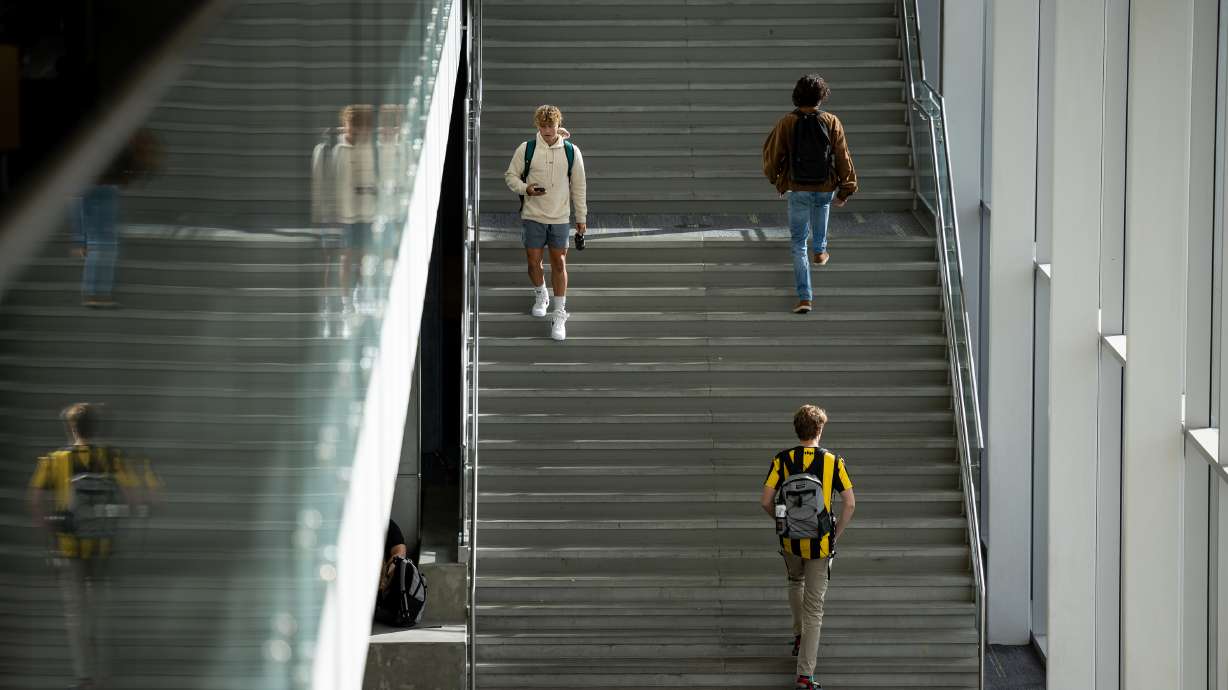Estimated read time: 4-5 minutes
This archived news story is available only for your personal, non-commercial use. Information in the story may be outdated or superseded by additional information. Reading or replaying the story in its archived form does not constitute a republication of the story.
SALT LAKE CITY — There's no doubt that the Beehive State is growing, and doing so at a rapid pace, but some population groups aren't growing nearly as fast as others.
The groups that are expected to lag behind, according to new research from the University of Utah's Kem C. Gardner Policy Institute, are school-age and college-age populations, respectively.
Population projections indicate an increase of over 284,000 residents in the school- and college-age groups in Utah between 2020 and 2060.
Despite the overall increase, this change is slower than in other age groups, and both age groups are expected to decrease as shares of the total population.
"While growth continues to be our constant companion in Utah, the same can't be said for certain age cohorts," said Mallory Bateman, Gardner Institute director of demographic research, in a statement. "As the state population reaches 5.5 million in 2060, the share of school- and college-age residents are projected to change from 21% and 11%, respectively in 2021, to 15% and 10%, by 2060. We provide this detailed look to help inform planning for future capital facility planning, student services and other educational needs."
Here's a breakdown of how the institute projects these populations to change over the next 40 years.
School-age projections
Research from the institute indicates an increase in Utah's school-age (or 5- to 17-year-old) population of nearly 106,000 between 2020 and 2060, with a 0.3% average annual rate of change.
However, this growth will not be uniform.
"The school-age population is projected to decrease throughout the 2020s and 2030s before recovering and resuming growth in the 2040s," the research brief says.
After this brief stint of growth, declines are projected to once again start in the 2050s.
Despite growth through the 2040s, projections show Utah's school-age population will grow slower than any other age group in the state.
From 2020 to 2060, the state's total population is expected to grow by 66%, with the 65-and-over population group quadrupling. While the school-age population is expected to grow by 15%, it also declines as a share of the state's total population.

So, where is driving most of the change in the state?
According to the projections, nearly 93% of the statewide change is driven by three counties: Utah, Washington and Cache.
"Utah County, expected to double in total population by 2060, is projected to drive two-thirds of the growth in Utah's school-age population in the same period," says the research brief.
The county is expected to gain over 73,000 school-age children, increasing by 46%.
Following Utah County is Washington County, which is projected to gain the second-largest number of school-age residents, adding nearly 16,000 school-age children.
Cache County ranks third for absolute growth in the school-age population, adding more than 9,000 school-age residents.
While these counties are all expected to experience growth, 13 counties in the state are anticipating declines in their school-age populations from 2020 to 2060, with Carbon, Millard, Salt Lake, Summit and Sevier counties projected to decline by more than 1,000 school-age residents.
College-age projections
Between 2020 and 2060, projections show that Utah's college-age (18- to 24-year-old) population will increase more than school-age populations with a growth of almost 178,000 residents at an average annual rate of change of 0.9%.
Like the school-age projections, this growth will not be uniform, either.
"This population is projected to increase significantly during the 2020s. Projections indicate that the college-age population will decline during the 2030s and early 2040s before transitioning back to a more moderated growth pattern," the research brief says.
From 2020 to 2060, the college-age population is projected to increase by 52%. Over that same time period, the population of adults 65 and older is expected to grow by more than 200%.
While the total college-age population is projected to increase, the group's share of the total population is expected to decrease from 11.5% to 9.5%.
Unsurprisingly, five of the six counties projected to experience the most significant increases in their college-age populations are home to higher education institutions.

Utah County again leads the way, with a projected increase of 63,000 college-age residents between 2020 and 2060, accounting for over 35% of the statewide college-age growth.
Salt Lake County pencils in behind Utah County, with a projection to add over 34,000 college-age residents in the same time span.
Davis County ranks third, adding almost 20,000 to its college-age population, while Cache, Weber, and Washington counties are each expected to add more than 10,000 college-age residents.
Additionally, the research says that past birth patterns can help paint the picture as to why the state is expecting to see fluctuations in its younger populations.
"In the 2021 long-term planning projections, the decrease in the school-age population between 2025 and 2035 corresponds to fewer cumulative births 5-17 years prior," the research brief says. "A projected decrease in the college-age population beginning in the 2030s corresponds to fewer births in the 2010s, followed by a projected decrease in births until the mid-2020s."
The full research brief can be found here.









